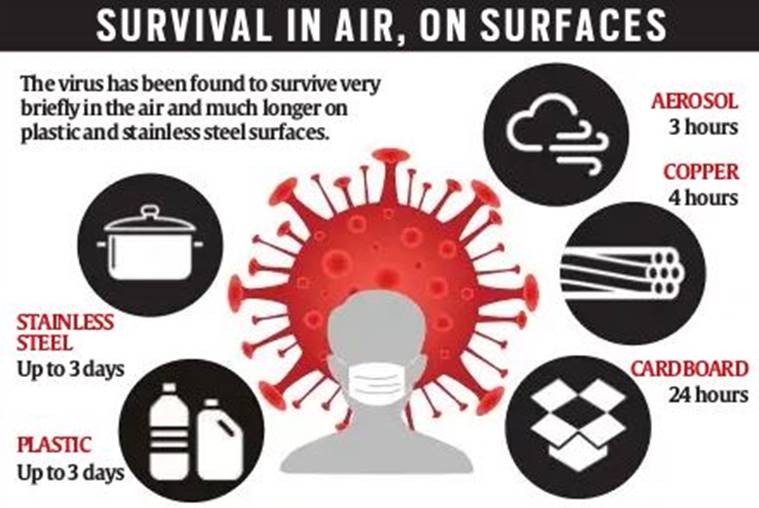A paper published in the New England Journal of Medicine on Tuesday has come out with new information on the longevity of the virus in the air — and on different surfaces.
Scientists across the world are still learning about the novel coronavirus, and among the questions they are looking to answer is how long it can survive in different environments. A paper published in the New England Journal of Medicine on Tuesday has come out with new information on the longevity of the virus in the air — and on different surfaces. An understanding of how long the virus survives is crucial to understanding how contagious it could be.
In the air: 3 hours, but weaker
The scientists, affiliated to different laboratories in universities in the United States, found in their experiments that the SARS-CoV-2 virus could survive in air for about three hours, although its ability to infect was severely weakened during this time. Until now, the virus was believed not to be able to survive in the air. As such, there was little risk of people getting infected through the air. The fact that it does survive in the air, even for a short time, could force scientists and health officials to reassess the risk to people, especially to health workers who spend a lot of time near an infected person.
Explained: Understanding ‘community spread’ of coronavirus— what is it, what does it entail?
“Our results indicate that aerosol (air) transmission of SARS-CoV2 is plausible, since the virus can remain viable and infectious in aerosols for hours…,” the study says.
Strongest on plastic and steel
The new study also finds that plastic and stainless steel surfaces are the most conducive for the virus to survive. The virus was found to be “viable” for as long as three days on these surfaces. On cardboard surfaces, the virus could survive for up to 24 hours, while on copper, it could barely last for four hours.
The longevity on each of these surfaces has implications for the kinds of things that people can be advised to come in contact with, or avoid. For example, during times of extended isolation, or forced homestays, people are likely to interact more with cardboard boxes while getting food and other products shipped to their residence. The fact that the virus does not survive beyond 24 hours on these surfaces might reduce worries on this front.
An Expert Explains: Why airports make you ill and what to do about it
But there is a lot more to learn
The scientists said the survivability of the SARS-CoV-2 virus on these surfaces was not drastically different from that of the SARS-CoV-1 virus, which had a similar but less deadly outbreak in mainly Asian countries in 2003. Therefore, they conclude that the reason for the much greater spread of SARS-CoV-2, as compared to the 2003 virus, “could arise from other factors (not any difference in their life spans), including high viral loads in the upper respiratory tract and the potential for persons infected with the SARS-CoV2 to shed and transmit the virus while (remaining) asymptomatic (without showing any symptoms of the disease)”.
Coronavirus: How often (and how) should you clean your home?
However, the latest findings may not be conclusive yet. Several similar studies have been done in the last few weeks, and more are ongoing. A study published in The Journal of Hospital Infection in February, for example, had surveyed the results of 22 earlier studies on different kinds of coronaviruses. It had found that coronaviruses had the ability to survive between two and nine days on different dry surfaces such as metal, paper, glass, plastic, and wood. That study was not specific to SARS-CoV-2, the coronavirus behind the current pandemic. That study concluded that since no specific therapy was available for SARS-CoV-2, “early containment and prevention of further spread” was the most crucial step in controlling its spread.
? The Indian Express is now on Telegram. Click here to join our channel (@indianexpress) and stay updated with the latest headlines
For all the latest Explained News, download Indian Express App.
Source: Read Full Article






